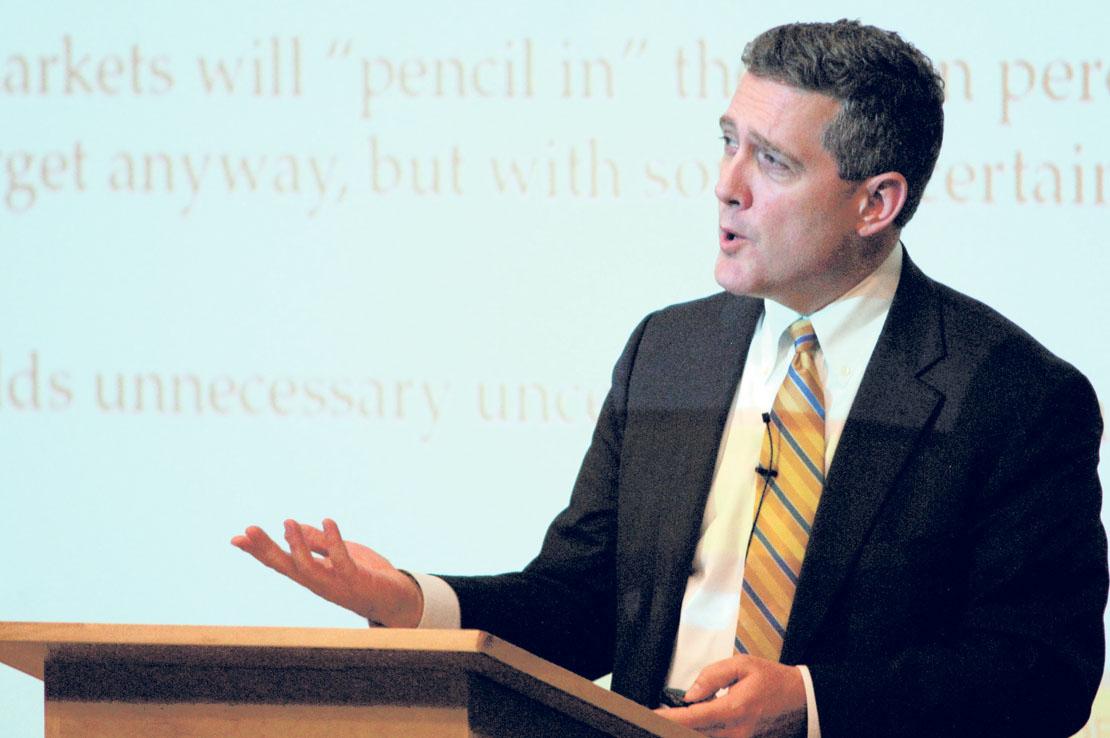CEO of federal bank describes interest rate policy
The Federal Open Market Committee set target inflation in January at 2 percent, and the goal in settling on this number is to promote stable prices, said James Bullard, CEO of the Federal Reserve Bank of St. Louis.
Inflation targeting and the Federal Reserve’s dual mandate – maximum employment and stable prices – are linked, Bullard said to a full auditorium Monday.
Representatives from the Jon M. Huntsman School of Business invited Bullard to USU to speak at this year’s George S. Eccles Distinguished Lecture, where Bullard was introduced by Doug Anderson, dean of the business college.
“He is one of the most important voices in the Federal Reserve today,” Anderson said. “I think he would like to refer to himself as the voice of reason, and we would certainly agree with that.”
Bullard presented a model the Fed uses to predict inflation based on household needs and said it is important to analyze households to maximize each household’s well-being.
“The models are forward looking,” Bullard said. “Why? Because the actors in the model are forward-looking, households are forward-looking.”
In this model, the central bank has power to change interest rates, which “offsets” shocks to the economy, he said. Because central banks have this power, the target inflation rate is always attainable, therefore keeping national employment high.
“These equations turn out the steady state level of consumption and the steady state level of labor supply,” Bullard said.
After global inflation in the 1970s, the Fed saw a need to release the adopted inflation target after historically keeping it from the public, Bullard said.
“Since the central bank controls the inflation rate,” he said, “there seems to be little to be gained from hiding the inflation target.”
When deciding on an inflation target, the Fed collaborates with multiple international central banks, including the European Central Bank, Bullard said.
The dual mandate applied in Bullard’s model is actually a triple mandate, he said – the third piece being the Fed’s aim to sustain moderate long-term interest rates.
“We are nailing the third one,” Bullard said. “And no one is giving us credit for that.”
The ECB follows a single mandate, and though it is different from U.S. central banks in this way, it doesn’t behave differently when impacted by economic turns, he said.
Recession lowers interest rates, and economic growth will raise interest rates, he said.
“Much of the discussion about the dual mandate is, in my view, really about the nature of the Fed’s reaction to economic events,” Bullard said.
During a press conference held after Bullard’s lecture, he spoke about the state of the economy. Bullard said many sectors are growing quickly, including retail and labor.
According to the National Employment Update released by the National Conference of State Legislatures, the national unemployment rate dipped slightly to 8.2 percent in March, from February’s 8.3 percent unemployment rate. Still, there are players in the recession-weakened economy.
“Some parts of the economy aren’t going to recover fast,” Bullard said. “Housing is not going to recover fast – some parts of financial markets are slow to come back.”
Though he maintains optimism regarding the next few economic years, thanks to increasing market numbers for the beginning months of 2012, he said he cannot forecast whether the economy will stay on track.
“The first quarter is coming in stronger than expected,” Bullard said, “It’s not super robust, but it’s better than people were expecting a few months ago.”
In an uncertain economy, Bullard said current students should maintain a broad perspective, and know that down economies don’t last forever. Students may be looking toward entering the workforce and becoming homeowners.
Luckily, Utah has one of the nation’s lowest unemployment rates, and housing affordability is high, Bullard said, adding that those looking to own homes should buy now, but buy carefully because it would be unwise to overborrow.
“I am not telling young people to go into this willy-nilly,” he said. “Go into it with your eyes open. If you decide to rent instead, you might pay a higher rent.”
Bullard, an undergraduate student in the early 1980s, said the economy was shaky at that point in time, too, but later stabilized.
“It’s a long road, so, even though conditions aren’t so great right now, you are really investing in yourself over a long period of time. So take some heart from that,” he said.
– catherine.meidell@aggiemail.usu.edu

